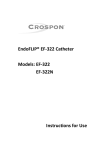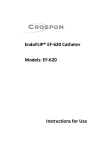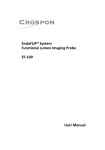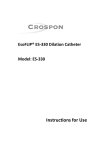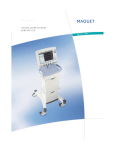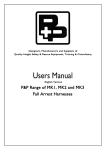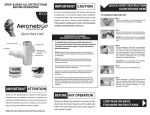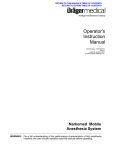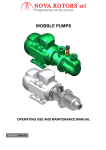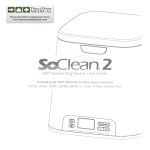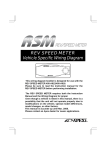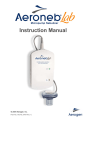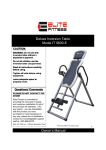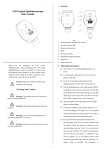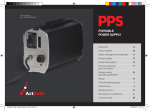Download EndoFLIP® EF-825 Catheter Models: EF-825 BF
Transcript
EndoFLIP® EF-825 Catheter Models: EF-825 BF-325 Instructions for Use Table of contents 1. 2. Introduction ........................................................................................ 3 1.1 How it works ................................................................................. 3 1.2 Intended Use ................................................................................. 4 1.3 Contraindications .......................................................................... 4 1.4 Warnings ....................................................................................... 4 Using the catheter ............................................................................... 5 2.1 Installing the catheter assembly ................................................... 5 2.2 Placing the catheter: Gastroesophageal Junction (GEJ) ................ 6 2.3 Placing the catheter: Gastric Band adjustment ............................. 7 2.4 Disconnecting the catheter ........................................................... 9 Appendix A: Specifications .......................................................................... 10 Copyright © 2014 Crospon Ltd. This document is the sole property of Crospon Ltd. No part of this document may be copied or otherwise reproduced, or stored in any electronic information retrieval system, without the prior consent of Crospon Ltd. EndoFLIP®, EsoFLIP® and FLIP® are registered trademarks of Crospon Ltd. ii EndoFLIP® EF-825 Catheter Instructions for Use, DD-646 Rev A 1. Introduction The EndoFLIP® EF-825 Catheter is designed for use with the EndoFLIP® System, which displays estimates of the diameters at 16 points over an 80mm measurement length along the balloon. The EndoFLIP® BF-325 Catheter is designed for use with the EndoFLIP® System, which displays estimates of the diameters at 8 points over a 40mm measurement length along the balloon. Throughout this document the EF-825 will also describe the use of the BF-325 unless the BF-325 is specifically referenced. 1.1 How it works The EF-825 Catheter acts as a functional lumen imaging probe (FLIP) that shows dynamic changes in the geometry of the measurement area in a real-time image. The catheter connects to an EndoFLIP® System, which injects a conductive solution into the catheter balloon placed in the measurement area. The balloon contains an array of electrodes that measure voltage. The EndoFLIP® System uses these voltages to estimate the diameter at 16 points, 5 mm apart, along the measurement area (see Figure 1). Refer to the EndoFLIP® user manual for a further description of the system. Catheter Balloon inflated with conductive solution Tissue Estimated diameter (Dest) measured at each electrode. EF-825: 16 measurements, 5mm apart. BF-325: 8 measurements, 5mm apart. Figure 1: EndoFLIP® EF-825 and BF-325 Catheter EndoFLIP® EF-825 Catheter Instructions for Use, DD-646 Rev A 3 1.2 Intended Use The following are the indications of use for the EndoFLIP® system and EF-825 catheter: In the USA: The EndoFLIP® System is indicated for use in a clinical setting as a dimension measurement device and as an adjunct to other methods in the comprehensive evaluation of patients with symptoms consistent with esophageal sensory hypersensitivity. It is also indicated for use to estimate the size of a stoma produced by a gastric band. Note: The EF-825 catheter is to be used only with the EndoFLIP® system. Outside the USA: The EndoFLIP® System is used in a clinical setting to obtain an estimation of the dimensions within the alimentary canal. 1.3 Contraindications • • The EndoFLIP® System is contraindicated where endoscopy is contraindicated. • The EF-825 catheter is not suitable for diameter measurements less than 5 mm. 1.4 Do not use the EndoFLIP® System on patients with actively-bleeding varices in the esophagus. Warnings • Do not reuse, reprocess, or re-sterilize. Reuse, reprocessing or re-sterilization can: compromise the structural integrity of the device; impair performance accuracy due to residual fluid in the balloon and degrade the catheter markings. • • Federal law (U.S.) restricts this catheter to sale by, or on the order of, a physician. • To ensure proper operation and to minimize the risk of patient injury, do not attempt to add or remove fluid from the supplied pre-filled syringes. Only use the pre-filled syringe supplied with the catheter. Note: Different catheter part numbers are supplied with different solution concentrations. • To avoid damaging the catheter and syringe, store away from sources of heat in specified environmental conditions (see Appendix A: Specifications). • Before using the EndoFLIP® System and catheter on a patient, allow the device to acclimate to conditions of use following transport or storage. 4 All catheter components are intended for single patient use only: do not attempt to reuse. Follow all applicable Federal and local regulations for disposal or recycling. EndoFLIP® EF-825 Catheter Instructions for Use, DD-646 Rev A • During operation, check that the amount of fluid in the syringe matches the amount shown onscreen, and verify that the syringe refills, as indicated when the plunger aligns with the arrow on the syringe (indicating that the balloon is empty) before carefully removing the catheter from the patient. • Verify that there are no leaks in the catheter during the pre-use purge cycle described in the EndoFLIP® System user manual. • Replace the catheter if a Dest value remains consistently at a maximum or minimum compared to adjacent Dest values; this can indicate a faulty catheter. • • Remove the catheter if the patient requires defibrillation. 2. Refer to the EndoFLIP® user manual for warnings relating to use of the EndoFLIP® System. Using the catheter This section describes how to install and use the EndoFLIP® EF-825 Catheter. 2.1 Installing the catheter assembly Warning: Before use, inspect the catheter assembly from end to end for breakage, occlusions, or debris. For single use devices, do not use if damage to the parts or packaging is evident, or if any portion of the package has been previously opened. Do not use any part after its expiration date or if the expiry date cannot be verified 1. Remove the catheter assembly from its packaging, remove the protective sheath from the balloon, and dispose of the sheath. 2. Place the balloon, tip first, into the EndoFLIP® pre-use checkout tube, which holds the balloon in a vertical position (see figure 2). Catheter with the balloon inside the Preuse checkout tube. Pre-use checkout tube. Figure 2: EndoFLIP® catheter in the pre-use check-out tube. 3. Prepare the catheter for use as described in the EndoFLIP® System user manual. EndoFLIP® EF-825 Catheter Instructions for Use, DD-646 Rev A 5 2.2 Placing the catheter: Gastroesophageal Junction (GEJ) Warning: Avoid using excessive force during insertion. Withdraw the catheter if resistance is too high. 1. Wipe down the catheter with an alcohol swab and apply lubrication to the catheter (if required). 2. Insert the catheter trans-orally or trans-nasally. For trans-oral insertion, use a laryngeal blade if needed to aid insertion. Insert the catheter until: - Trans-oral: the 45-cm mark on the catheter aligns with the patient’s teeth. Trans-nasal: the 55-cm mark aligns with the patient’s nose. If you feel any resistance during insertion, retract the catheter slightly, then carefully retry. Note: the patient’s physiology, e.g. a hiatal hernia, may require the anatomy to be mobilized and straightened before advancing the catheter into the stomach. 3. 4. 5. 6. 7. 6 Inflate the balloon to 30 ml. Slowly retract the catheter to position the GEJ toward the middle of the balloon (center of the EndoFLIP® screen). To assist in positioning the catheter in low light environments, apply tape to the catheter shaft to indicate the distance from the patient’s teeth to the GEJ. Adjust the balloon position as required to center the image of the GEJ at the balloon. When the procedure is finished, deflate the balloon fully, as indicated when the plunger aligns with the arrow on the syringe (See Fig. 5) and carefully remove the catheter from the patient. EndoFLIP® EF-825 Catheter Instructions for Use, DD-646 Rev A Catheter assembly Catheter balloon Catheter balloon GEJ Catheter markings are referenced from center of balloon 0 = center of balloon Figure 3: Balloon placement in the measurement area (e.g. GEJ) Note: The markings on the catheter are referenced from the center of the balloon. 2.3 Placing the catheter: Gastric Band adjustment Warning: Avoid using excessive force during insertion. Withdraw the catheter if resistance is too high. 1. Wipe down the catheter with an alcohol swab and apply lubrication to the catheter (if required). 2. If the procedure includes a hiatal hernia repair, the catheter should be inserted before the repair, otherwise the catheter should be inserted before the band is closed. 3. With no fluid fill in the gastric band, insert the catheter trans-orally, and position the balloon centrally within the gastric band. If using fluoroscopic guidance, the measurement electrodes are clearly visible (see Figure 4). EndoFLIP® EF-825 Catheter Instructions for Use, DD-646 Rev A 7 Catheter assembly Catheter balloon Catheter markings are referenced from center of balloon 0 = center Gastric band Catheter balloon Figure 4: Balloon placement within the gastric band If the gastric band position is known from endoscopy, use the catheter markings to guide balloon placement. Alternatively, you can insert the catheter trans-nasally. For trans-oral insertion, use a laryngeal blade if needed to aid insertion. Insert the catheter until: - Trans-oral: the 45-cm mark on the catheter aligns with the patient’s teeth. Trans-nasal: the 55-cm mark aligns with the patient’s nose. If you feel any resistance during insertion, retract the catheter slightly, then carefully retry. Note: the patient’s physiology, e.g. a hiatal hernia, may require the anatomy to be mobilized and straightened before advancing the catheter into the stomach. 4. 6. Once the banding procedure is complete, inject 2 cc (2 ml) into the band and inflate the EndoFLIP® balloon to 30 ml. Referencing the EndoFLIP® screen, slowly retract the catheter until you feel resistance. As you retract the catheter you should see the stoma moving from the top of the image toward the middle of the balloon (center of the screen). If not, inflate the balloon to 40 ml. Retract the catheter until the stoma is positioned at the center of the screen. 8 EndoFLIP® EF-825 Catheter Instructions for Use, DD-646 Rev A 5. 7. 8. 9. If the diameter at the band position reads 5mm or less, inflate the balloon to 40 ml. Add or remove fluid to/from the band until the intended stoma diameter is achieved. Deflate the balloon fully, as indicated when the plunger aligns with the arrow on the syringe (See Fig. 5) and carefully remove the catheter from the patient. Cautions: • Any gastric band adjustments should be carried out solely in accordance with that gastric band manufacturer's instructions for use. • The relationship between band stoma diameter and weight loss has not yet been clinically established. Notes: • The markings on the catheter are referenced from the center of balloon. Syringe returned to original position: plunger aligns with arrow Figure 5: Syringe returned to original position Warning: In the unlikely event that the EndoFLIP® System stops normal operation during a procedure, use the back panel on/off switch to turn the unit off, remove the syringe from the unit and retract the syringe plunger manually to withdraw any remaining fluid from the balloon catheter. The catheter can then be carefully removed from the patient. 2.4 Disconnecting the catheter Once the procedure is complete and the balloon is deflated (as described in the EndoFLIP® System user manual), disconnect the catheter and syringe from the unit, and check the structural integrity of the catheter. Warning: Single use device, follow all applicable Federal and local regulations for disposal or recycling of the syringe and catheter. EndoFLIP® EF-825 Catheter Instructions for Use, DD-646 Rev A 9 Appendix A: Specifications Operating and storage conditions Operating conditions Temperature 20 to 40 °C Humidity 15 to 95% relative humidity (non-condensing) Atmospheric pressure 700 to 1060 hPa Storage conditions Main label symbols Temperature 0 to 25 °C Humidity 10 to 95% relative humidity (non-condensing) Atmospheric pressure 500 to 1060 hPa Single-use device Storage temperature limits Use-by date Fragile Manufacturer 10 EndoFLIP® EF-825 Catheter Instructions for Use, DD-646 Rev A Batch code Part number Caution, consult accompanying documents CE Mark and Notified Body Number: product complies with requirements of the Medical Device Directive 93/42/EEC Date of Manufacture Rx ONLY Xn Caution: Federal law restricts this device to sale by or on the order of a physician. Box contains quantity ‘n’ catheters Catheter Specifications Maximum Inflate Volume 50ml Maximum Inflate Rate 60ml/min Dest Measurement Range 5mm-25mm Dest Measurement Accuracy ±1mm over measurement range. EndoFLIP® EF-825 Catheter Instructions for Use, DD-646 Rev A 11 Manufacturer information Crospon Ltd. Galway Business Park Dangan Galway Ireland Europe: Phone: +353-91-519880 Fax: +353-91-519889 email: [email protected] US: Phone: 1-855-CROSPON Fax: 760-406-5644 email: [email protected] 12 EndoFLIP® EF-825 Catheter Instructions for Use, DD-646 Rev A












